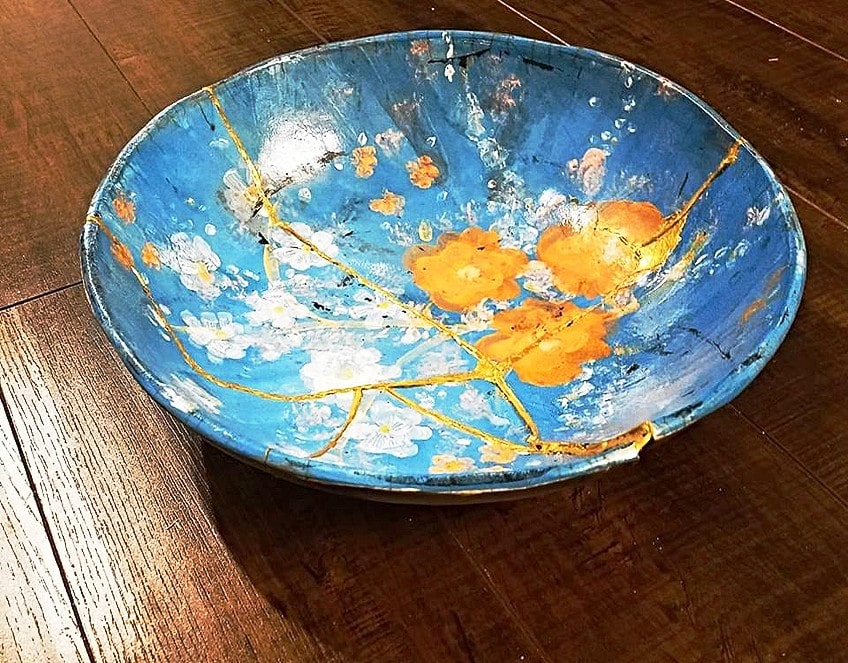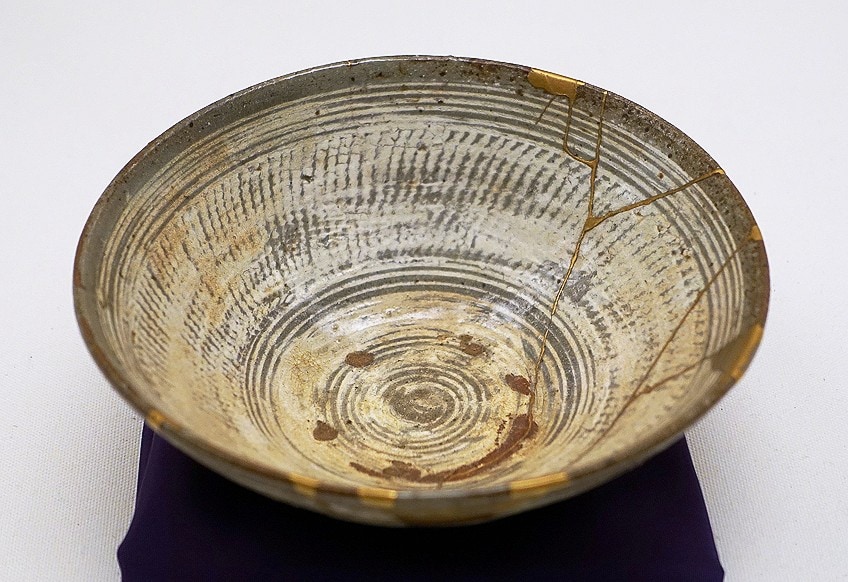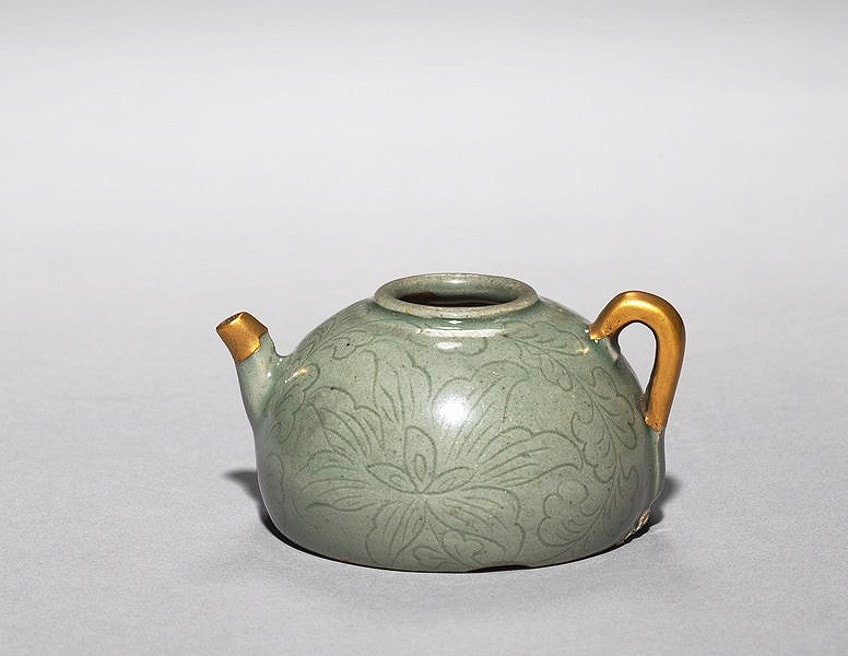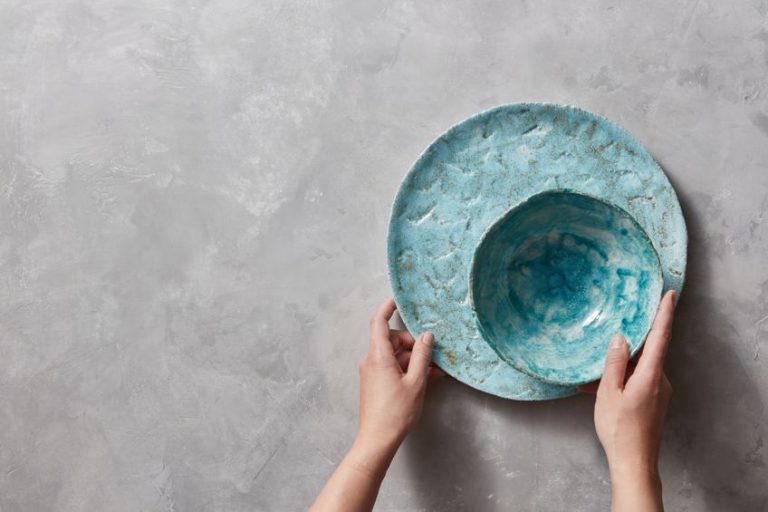Kintsugi – Explore the Beautiful Art of Japanese Broken Pottery
Kintsugi art is also referred to as Kintsukuroi and is an ancient tradition involving the repair of Japanese broken pottery. The cracked pots were fixed by filling the broken areas of the Japanese Kintsugi bowls with powdered gold, platinum, or silver. Kintsugi pottery, as a philosophy, views shattering and restoration as a natural part of cracked pots’ history, instead of something which should be hidden.
The Kintsugi Art of Mending Japanese Broken Pottery
Japanese gold cracks are viewed as aesthetically pleasing rather than ugly. Japanese Kintsugi art, in fact, frequently makes the restored object more attractive than the original, renewing it with a new aesthetic and giving it a fresh lease on life. Exquisite Japanese gold cracks gleam in the visible fractures of Kintsugi bowls once finished, providing each reconditioned piece with a one-of-a-kind character.
The Kintsugi meaning quite simply refers to the term “golden joinery”. The term “Kintsukuroi” is also often used and can be translated as “golden repair.”
The Origins of Japanese Kintsugi Art
Lacquerware has a long history in Japan, and Kintsugi and Kintsukuroi may have been coupled with maki-e at some time to replace previous Japanese broken pottery repair processes. While this method of repairing cracked pots is most commonly associated with Japanese artisans, it has also been used on ceramics from Vietnam, China, and Korea.
While the exact origins of Kintsugi are unknown, scholars assume it dated from the late 15th century. According to mythology, the technique began when shogun Ashikaga Yoshimasa returned to China to have a damaged tea bowl repaired.

Yoshimasa was disappointed to see that it had been repaired with unattractive metal clips upon its return. Kintsugi was created as a result of contemporary craftsmen’s desire to find an alternate, visually beautiful way of repair. Collectors were so enthralled with Kintsugi pottery that some were suspected of purposefully shattering priceless pottery so that it might be mended with kintsugi’s gold seams. Kintsugi had grown popular in Japan by the 17th century.
During this period, a Japanese samurai made a name for himself by buying, breaking, and repairing common tea Kintsugi bowls for a profit. This suggests that, by the beginning of the 17th century, kintsugi was a widely utilized method for mending and ornamenting tea-related pottery.
It’s also conceivable that a ceramic piece was picked for abnormalities acquired during manufacture and then purposefully shattered and restored rather than discarded. On the other hand, because it signified beauty in shattered things, such “awfulness” was regarded as uplifting and Zen-like. The bowl gained even more value as a result of these enormous metal staples that resembled locusts, and the bowl was dubbed a “giant-locust clamp.”
The Philosophy of Japanese Gold Cracks
The Kintsugi meaning and significance are related to mushin, a Japanese philosophy that covers the principles of non-attachment, embracing impermanence, and fate as parts of human existence. The utilization of an object’s wear markings is valued in Japanese aesthetics. Not only is there no effort to conceal the damages, but the restoration is actually lit up a tangible manifestation of mushin’s spirit.
It is typically interpreted as “no mind,” but it also connotes fully present in the now, non-attachment, and serenity in the face of change.

The fluctuations of existence through time, to which all people are subject, are exemplified by the cracks, bangs, and shattering that ceramic ware is subjected to. This might be seen as a justification for keeping a damaged thing around.
Kintsugi is comparable in thought to the philosophy of wabi-sabi, which embraces the defective or imperfect, as well as several other philosophies which are incorporated into the Kintsugi way of thinking.
Wabi-Sabi
Wabi-sabi is all about embracing flaws and existing simply. Everyone passes through difficult moments, and living a flawless existence isn’t always possible. Wabi means “alone” in Japanese, and Sabi refers to the passing of time. They show us how to accept both the good and terrible aspects of ourselves, as well as the imbalance of life, by working together. We embrace our strengths by embracing the flawed.
This mentality shift, from aiming for an unreachable ideal to appreciating our capabilities, results in a more constructive and strength-oriented outlook.
Gaman
Gaman is the capacity to persevere, be calm, and have a serene demeanor. Gaman can be practiced in daily life by meditating, visualizing, or just taking a few seconds to breathe. We are giving our thoughts a vacation by concentrating on something as simple and important as breathing. Every day, you may exercise resiliency through how you respond to daily pressures. Rather than focusing on the bad, Kumai suggests looking at problems as a chance to grow.

Gaman urges us to delve into our inner power and concentrate on our ability, whether we’re going through something as significant and life-changing as a breakup or just trying to get through a hard work week. It is far more effective than anything negative to cultivate inner strength.
Yuimara
The Kintsugi art tradition of appreciating unity is known as yuimaru. Through the power and sustenance of family and friends, Yuimaru assists you in healing. You can take very good care of yourself if you take better care of your innermost circle.
We may be nicer to ourselves by deepening our connections. We tend to take better care of ourselves when we feel we have a robust support system. The act of giving and accepting has emotional repercussions.
Eiyoshoku
A robust, healthy body is the foundation for a good mentality. The act of seeing and tasting food nourishes both the body and the mind. The sort of food we consume is related to the body-mind connection, so when we nourish our organs with a basic, nutritious diet, our brains will benefit as well. We rob ourselves of the chance to recharge our bodies and brains when we eat carelessly or unhealthily. Self-care includes nourishing oneself from the inside out.

Kansha
Kansha, or the practice of expressing thanks for both the good and the terrible, is perhaps the most significant notion in Kintsugi wellbeing. You can recover quicker and be more tenacious when you recognize what you have. Gratitude also entails being present in the moment and not longing for things you don’t have.
Kansha is defined as letting go of one’s ego and reframing situations in such a way that your brain is rewired to perceive the good rather than the bad.
Gratitude encompasses both the good and the bad. There is a cause for everything, and no terrible situation comes our way without the need for a reason. That mission is for us to become better, more resilient, and appreciative people.
Methods of Creating Kintsugi Pottery
Kintsugi is divided into three styles and approaches. One method is called “crack”, another is known as “joint-call” and there is also the “piece” method. With the “crack” method objects that have been repaired by cracking are given a light coat of lacquer. This is the most frequent Kintsugi method, which results in the shimmering veins that have become synonymous with the art style.
When a substitute ceramic fragment is not obtainable and the whole enhancement is gold or a gold/lacquer composite, the “piece” approach is employed.

Parts restored using the joint-call method combine two visually diverse works into one distinctively united product by employing similar-shaped pieces from other shattered commodities. Staple repair is a technique for repairing damaged ceramic pieces that involve drilling tiny holes on either side of a fracture and bending metal staples to keep the pieces together.
The staple repair method was utilized as a restoration procedure for exceptionally costly artifacts in Europe (including England, ancient Greece, and Russia) and China.
Cultural Influences
Kintsugi is a Japanese idea that emphasizes flaws by seeing mends and flaws as an addition or a place to enjoy or focus on, rather than the lack or missing components. Modern designers and artists use the ancient practice to explore the concepts of loss, synthesis, and improvement via demolition, restoration, and resurrection.
Kintsugi and similar repair procedures have been exhibited in exhibitions at many renowned institutions, despite being first overlooked as a separate art form.
Charlotte Bailey, a British artist who was motivated by kintsugi to make textile pieces involving the mending of shattered vases, uses fabric to conceal the fragments and gold metallic threading to sew them back together. Karen LaMonte, an American artist who produces massive sculptures of women’s clothes worn by virtually invisible human figures, employed kintsugi methods to restore the ceramic sculptures after a kiln explosion shattered a number of them.
George Inaki Root, a New York designer, collaborated with Japanese craftspeople to develop the “Kintsugi” collection for his jewelry brand Milamore; Root told Forbes that the creations were motivated by concepts of elegance and fragility, as well as his lifelong affinity to kintsugi beliefs.

Victor Solomon, a Los Angeles artist influenced by kintsugi techniques and ideas, created “Kintsugi Court,” a cracked public basketball court in South Los Angeles that he mended using gold-dusted epoxy. The project was completed in 2020, just in time for the resumption of the NBA season, which had been halted due to the Covid-19 epidemic.
During the COVID-19 epidemic, the concept and practice of kintsugi provided solace. It has been used as a symbol for reconstructing after sad occurrences such as loss, illness, trauma, and disruptions in daily life.
“Post-traumatic development is like kintsugi for the psyche,” writes Kirsten Weir in the American Psychological Association’s quarterly Monitor on Psychology in 2020, while The BMJ describes kintsugi ideology as a great tool for recovering after the sadness of losing a loved one to COVID-19.
This one-of-a-kind process emphasizes each item’s unique history by stressing its faults and fractures rather than covering or concealing them. Japanese Kintsugi art, in fact, frequently makes the restored object even more attractive than before, renewing it with a new appearance and granting it a second life. Once finalized, brilliant seams of gold gleam in the prominent fractures of ceramic ceramics, giving each restored a wholly unique look. If you are interested in pottery, we suggeste you to also read our jomon pottery and ceramic ideas article.
Frequently Asked Questions
What Is Kintsukuroi or Kintsugi Pottery?
We toss away a bowl, teapot, or exquisite vase furiously and sadly when it falls and smashes into a thousand pieces. However, there is an option: a Japanese technique that accentuates and intensifies the breaks, so increasing the value of the shattered object. It’s known as kintsugi. This ancient Japanese technique employs a precious metal — liquid gold, silver, or lacquer sprinkled with powdered gold – to bind together and highlight the cracks in a shattered porcelain object. The process entails connecting pieces and providing them with a new, polished appearance. Because of the unpredictability with which ceramics smashes and the uneven patterns generated that is amplified by the use of metals, each mended piece is unique. Because of the distinct fractures generated when the item breaks, as if they were scars that leave different traces on each of us, this approach allows for the creation of authentic and always unique pieces of art, each with its own narrative and charm.
What Defines the Kintsugi Meaning and Purpose?
Many things are suggested by the kintsugi method. We should not discard damaged items. When an object breaks, it does not cease to be useful. Its flaws have the potential to be beneficial. We should endeavor to fix things since doing so can lead to the acquisition of more valuable items. This is the essence of fortitude. Each of us should seek a good approach to cope with traumatic situations, learn from terrible experiences, take the best from them, and persuade ourselves that it is precisely these observations that make each person unique and valuable.
Where Did Kintsugi Come From?
After shattering his favorite cup of tea, Ashikaga Yoshimasa, the shogun, sent it to China to be mended. Unfortunately, the artifacts were mended with unattractive and ineffective metal ligatures at the time. The cup appeared to be unrepairable, but its owner chose to have some Japanese craftsmen fix it. They were taken aback by the shogun’s tenacity, so they decided to turn the cup into a gem by sealing the gaps with lacquered resin and powdered gold.
In 2005, Charlene completed her Wellness Diplomas in Therapeutic Aromatherapy and Reflexology from the International School of Reflexology and Meridian Therapy. She worked for a company offering corporate wellness programs for a couple of years, before opening up her own therapy practice. It was in 2015 that a friend, who was a digital marketer, asked her to join her company as a content creator, and this is where she found her excitement for writing.
Since joining the content writing world, she has gained a lot of experience over the years writing on a diverse selection of topics, from beauty, health, wellness, travel, and more. Due to various circumstances, she had to close her therapy practice and is now a full-time freelance writer. Being a creative person, she could not pass up the opportunity to contribute to the Art in Context team, where is was in her element, writing about a variety of art and craft topics. Contributing articles for over three years now, her knowledge in this area has grown, and she has gotten to explore her creativity and improve her research and writing skills.
Charlene Lewis has been working for artincontext.org since the relaunch in 2020. She is an experienced writer and mainly focuses on the topics of color theory, painting and drawing.
Learn more about Charlene Lewis and the Art in Context Team.
Cite this Article
Charlene, Lewis, “Kintsugi – Explore the Beautiful Art of Japanese Broken Pottery.” Art in Context. May 3, 2022. URL: https://artincontext.org/kintsugi/
Lewis, C. (2022, 3 May). Kintsugi – Explore the Beautiful Art of Japanese Broken Pottery. Art in Context. https://artincontext.org/kintsugi/
Lewis, Charlene. “Kintsugi – Explore the Beautiful Art of Japanese Broken Pottery.” Art in Context, May 3, 2022. https://artincontext.org/kintsugi/.









